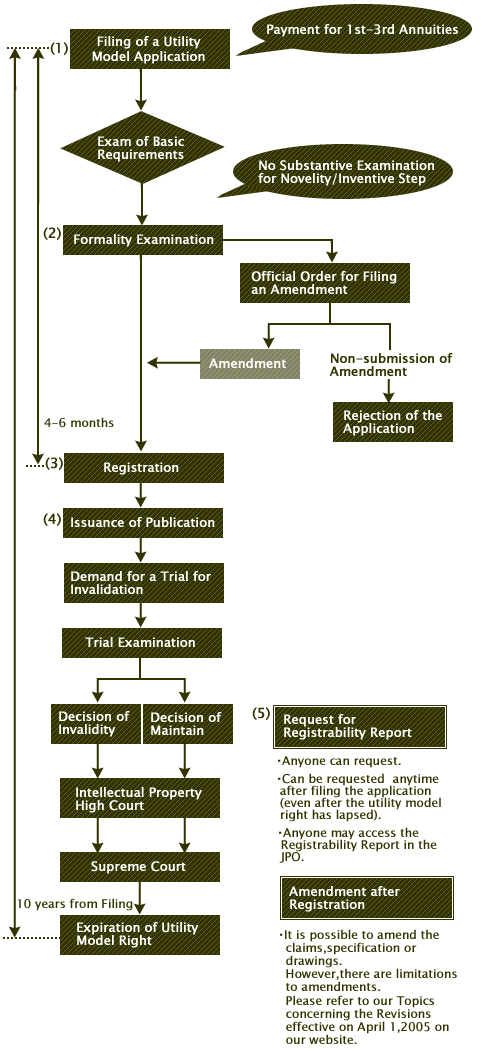2006.02.03
Utility Model or Patent?
Why Choose a Utility Model?
A utility model is intended for inventions that do not have the same level of invention as patentable inventions do, but which need protection in a shorter time frame than can be obtained by patents, and need the protection for a shorter time period. A utility model application is recorded as a utility model registration without substantial examination of novelty and inventive steps, typically within 4-6 months from the filing date of the application.
Utility model protection is less expensive than the protection provided by patents. However, the protection period cannot extend more than 10 years, which is shorter than that of a patent (20 years from the filing date). You should apply for a utility model if the life cycle of your invention is short, if the potential profit does not warrant patenting costs, or where there is a strong possibility to have counterfeit goods.
A utility model application can be converted into a patent application within 3 years from the date of filing the utility model application. If the invention achieves substantial commercial success, you may wish to convert the utility model application into a patent application to provide longer and more secure protection if the application is granted as a patent.
Notwithstanding, a utility model right is not generally a practical way to protect intellectual property as the registrant of the utility model must be extraordinarily careful in enforcing the right against infringements in comparison to patent rights. Sometimes it is not possible to enforce utility model rights.
Therefore, the registrant can employ utility model registration as a strategy for disclosing the invention. That is, the registrant can use utility model registration for discouraging competitors in the same art from using the invention, or for advertising purposes by showing that the invention has been recorded as a utility model right in Japan .
Utility Model Protection:
- Pharmaceutical products, materials, and chemical substances are not protectible subject matter under a utility model registration.
- Unlike a patent, a method, such as product management or a manufacturing process, and a product claimed as a result of a process, are not protectible subject matter under a utility model right.
- Terms of Protection: 10 years (for applications filed on or after April 1, 2005 )
Enforcement of Utility Model Rights:
Before pursuing an infringement action, it is necessary to first send a warning letter to the infringer together with a Registrability Report. The registrant can then enforce their rights based on the utility model registration.
However, if the Japan Patent Office thereafter concludes that the utility model registration should be canceled, the registrant has the responsibility to compensate the infringer for any damages incurred by the registrant because of any warning and enforcement action by the registrant. Further, unlike a Patent case, the burden of proof is on the registrant, not the infringer, and is responsible for preparing documentation to prove the validity of the utility model registration. Therefore, if the registrant cannot prove the validity of its enforcement action, the registrant is liable for the damages incurred by the infringer.
The range of search for prior art in the Registrability Report is narrow and limited. There is a tendency to omit searching English public domain documents. Therefore, there are oftentimes more reasons for invalidation than the information in the Registrability Report. Accordingly, we strongly recommend that the registrant search in greater depth prior to pursuing an action for infringement.
As discussed, a utility model right has disadvantages in that there are difficulties in enforcing the right. Accordingly, relatively few utility model applications have been filed in Japan.
What is a Registrability Report?
A Utility Model Registrability Report is an assessment report by the Japan Patent Office. In the Registrability report, an examiner provides an expert opinion on registrability of a utility model in such aspects as novelty and inventive step based on the result of a prior art search.
After a utility model application is filed, anyone can request a Registrability Report even after the right is extinguished. Also, anyone may access the Registrability Report in the Japan Patent Office.
| Patent | Utility Model | |
|---|---|---|
| Substantive Examination | Yes; In order to be examined, a Request for Examination must be filed within 3 years from the filing date | No |
| Term Required to Complete Registration | After 2-3 years from the date of filing a Request for Examination | After 4-6 months from the filing date |
| Term of Right | 20 years from the filing date | 10 years |
|
Advantages |
|
|
|
Disadvantages |
Takes several years for patent grant |
|
Flow Chart for Obtaining a Utility Model
